Importance of choosing the best time to trek Everest Base Camp
Unlocking the best time to trek to Everest Base Camp is one of the important factors that should be known before planning the journey. However, the Everest Trek can be done in two ideal seasons i.e. Spring seasons and Autumn Seasons. During these seasons or times, the experience will be amazing because it offers the incredible Himalayan vista, majestic surroundings, delightful landscapes, blooming forests embellished with rhododendron, pine-oak and many more.
Walking in the surreal landscape of the wilderness Himalayan region presents thrilling challenges along with the backdrop of magnificent peaks. On a sunny and long day, the entire trekking in the Everest region will be enjoyable and remarkable. Only possible when the journey is embarking at the best time.
Choosing the best time to visit Everest Base Camp is essential for a prosperous and enjoyable experience. Here are some important factors that may enhance the journey.
Weather conditions: The weather conditions are the main factors to smoothen your journey and provide an amazing trekking experience. The best time to trek to Everest Base Camp is during the pre-monsoon (spring) and post-monsoon (autumn/fall) seasons. During these times, the weather is generally reliable, with clear skies and great temperatures, making the trekking situation commendable and offering exceptional clear vistas of the magnificent landscapes.
Clear Visibility: Clear visibility is one of the most crucial for relishing the panoramic views of the Himalayas, including the iconic Mount Everest itself. Opting for the best time guarantees a crystal-clear sky and no chance of fog, clouds, or heavy rainstorms, making the trekking trail more challenging and covering the Himalayas.
Comfortable Temperature: Temperature at higher altitudes can vary substantially depending on the season and might be unpredictable for some time. However, trekking during the spring and autumn seasons provides lenient temperatures, and offers comfortable time for traversing in rugged terrain compared to the chilly cold of winter or the heat of summer. With mild temperatures, the journey will be easy walking to the base camp.
Enhanced Safety:Eternal Himalaya will always prioritize the safety of our clients. Walking in Himalayan terrain, there might be hurdles and difficulties. To diminish the risk of encountering adverse weather conditions such as heavy snowfall, avalanches, or monsoon-related hazards like landslides and flooding, choose the best time to do the Everest base camp trek.
The importance of choosing the best time to do the EBC trek bestows a memorable and satisfying trekking experience in one of the world's most iconic mountain regions.
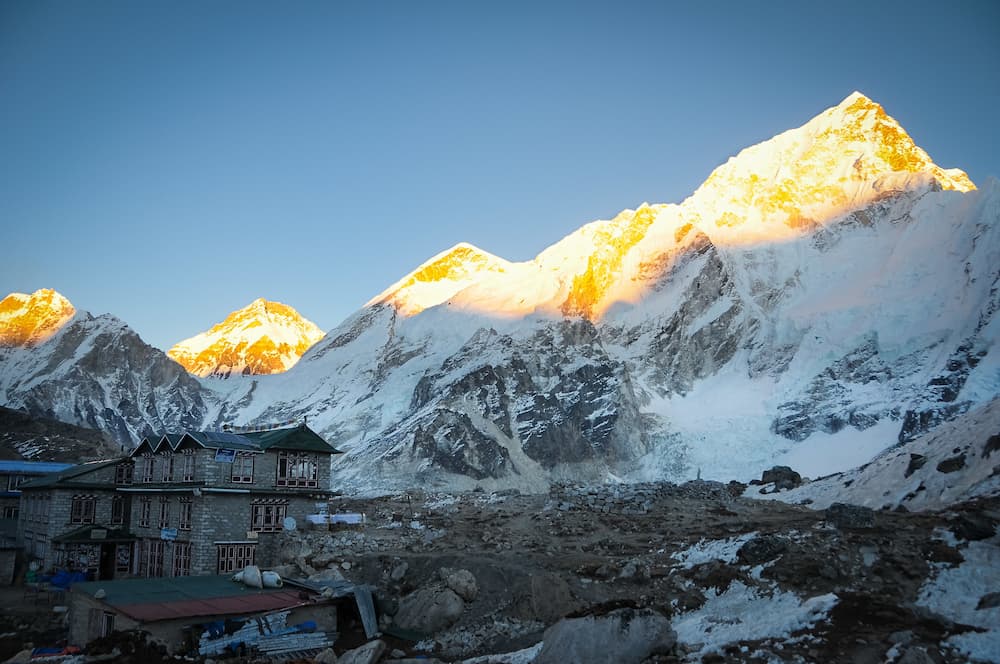
Impact of seasons on Everest trekking experience and difficulty
Simply, if you plan the journey during the best time to do the trek – the experience will be amazing and set an indelible mark for a lifetime and the trail will be somehow difficult in some path. Without consenting about the best time for this Everest trekking, undoubtedly, the journey will be challenging to achieve the ultimate desired destinations. In addition, the experience will be unsatisfying.
The seasons will greatly impact your ultimate adventure and result in bad experiences throughout the entire trek. So, choose wisely, take your time and make a plan to achieve the desired destination. Then the Everest journey will be amazingly memorable for a lifetime. Everest Base Camp Trek takes you 5000m above sea level which is not easy to conquer but if the time you choose is the best then the journey will be enjoyable and convenient.
Everest Base Camp Trek in Spring Season (March to May):
Spring Season is the ideal time to undertake the Everest Trek for a great experience and to reduce the risk encountered on the Everest Trail. From March to May, the journey will be enjoyable through the trail embellished with blooming rhododendrons and other vibrant flowers, enhancing the beauty of the region. Generally, the spring season offers great weather conditions, clear skies, visibility and mild temperatures making it the best time for Everest region trekking.
This is the busiest season on the Everest Base Camp trek, with more trekkers on the trail you’ll get a chance to interact with other people and get knowledge about their experiences. Most Everest summits can be done during these months so encounter many climbers, summiteers, and crew members. Be amazed at the surreal beauty of the region. Witness the incredible sights of Mount Everest, Mt. Lhotse, Mt. Amadablam, and more during this season. Assuredly, an amazing lifetime experience this summer season.
Everest Base Camp Trek in Summer/Monsoon season (June to August):
The challenging season to conquer the Everest Base Camp is during the Monsoon season. During this time, it brings heavy rainfall and cloudy skies, diminishing visibility and making trekking conditions thrillingly challenging. The trails become muddy and slippery, raising the risk of landslides and floods, making some sections blocked.
Trekking during this monsoon season will encounter leeches, mainly in the lower altitude region. The monsoon season is more difficult due to bad weather conditions, slippery trails, and the risk of landslides and flooding. It's generally not recommended for trekking. But if you’re well prepared for drenching in the rain, then opt for some regions of the trek that occur less rain during this season such as Upper Mustang Trek, and Upper Dolpo Circuit Trek. Undoubtedly, these treks will provide once in a lifetime experience.
Everest Base Camp Trek in Autumn/Fall (September to November):
Autumn/ Fall is another perfect time to visit Everest Base Camp, the season offers amazing weather conditions which leads to clear skies, feasible temperatures, and amazing visibility of the top Himalayas. Revel in the stunning views of the surrounding mountains, with frangible air and vibrant landscapes.
During this season, the crowd is not as in spring, autumn still sees a notable number of travellers on the trail, mainly in October. Trekking conditions are generally favourable during autumn, with stable weather and clear trails, making it one of the best times to trek to Everest Base Camp. Perfect seasons to explore the worldwide popular sites with indelible memory in heart and soul.
Everest Base Camp Trek in Winter (December to February):
Winter seasons bring cold temperatures, especially at higher elevations, along with a high possibility of snowfall. Although the Everest trek can be possible during that time, the trail offers a quieter experience but the chilly temperature will make it difficult to conquer some point in the trek. The trails may be covered in snow, making trekking more challenging, especially in high passes.
Winter trekking is the most challenging due to cold temperatures, snow-covered trails, and the risk of hypothermia. However, for experienced trekkers looking for wilderness and distinctive winter scenery, it can be a worthwhile experience. In this season, if you’re planning to trek the mountain views can be seen clearly which will surely take your breath away. However, the price may drop because of the off-season.
If you're comfortable with chilly temperatures, then the winter season emerges as the best time for hiking to Everest Base Camp.
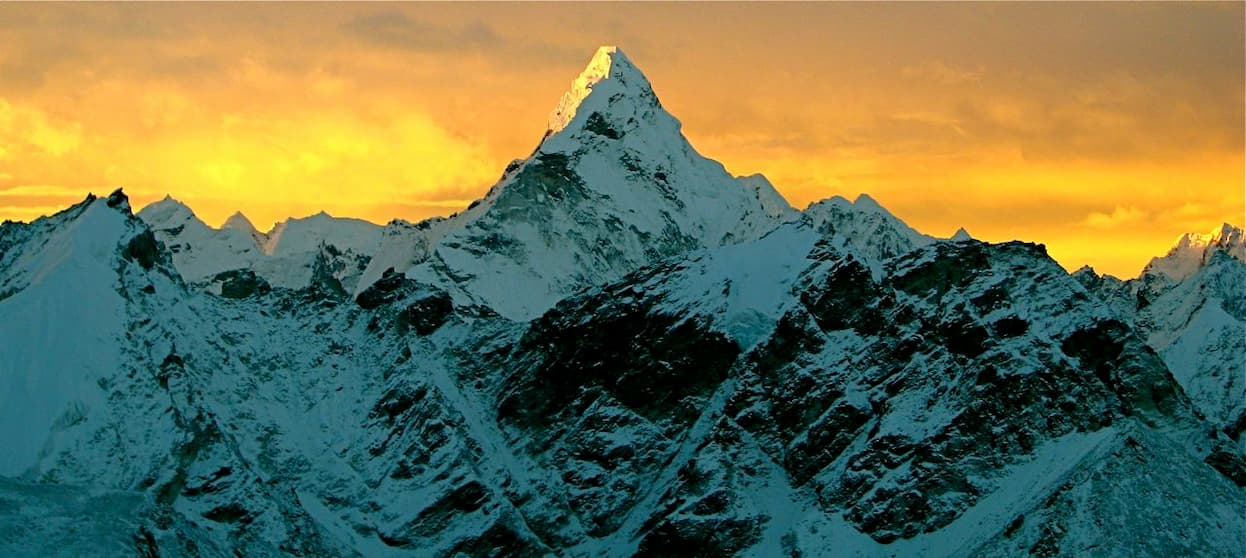
How hard to hike to Everest Base Camp?
The seasons play a significant role in Everest Base Camp Trek to increase and decrease the difficulty level. Choosing the best month to conquer the EBC will reduce the hurdles and provide a convenient way to set foot on the world’s highest base camp. However, Everest Base Camp Trek is one of the moderately challenging treks in Nepal which requires a basic level of physical and mental fitness. The trek includes a couple of steps ascending and descending, a continuous walk of 6-7 hours, a rugged and remote landscape, and immediate ascending to o higher altitude. Here are several factors that may cause difficulty during the trek:
Rugged Terrain:
The Everest terrain takes you from rugged trails to steep ascents and descents in which the sections include rocks and narrow bridges. Walking on some rocky paths is one of the challenges to pass in this trek. So be prepared for these kinds of hurdles encountered throughout and make sure to be well-fitted to conquer the journey.
Unpredictable Weather condition:
Weather conditions play a major role while trekking in the Everest Region. In higher altitude regions, the weather might be unfavourable and harsh with temperature significantly dropping down. Be prepared for cold temperatures and potential weather changes as you land on higher altitudes.
EBC elevations
EBC trek is one of the highest treks that takes you to higher elevations, reaching over 5,000 meters (16,400 feet) above sea level. Altitude sickness is the main risk while you are trekking in a high-altitude region. It may occur to anyone who is not acclimatized properly, leading to symptoms like headache, nausea, and fatigue. Acclimatization, maintaining hydration level, and proper diet are crucial to prevent altitude sickness.
Trek Duration:
The trek to Everest Base Camp typically takes around 12-14 days, covering a distance of 130 kilometres (80 miles) round trip. Walking for long hours each day over two weeks requires a good level of fitness and endurance.
If you consider the above-mentioned factors, the trek may ease you at some points.
Ideal itinerary for Everest base camp Trek
Day 1: Arrival in Kathmandu
Day 2: Kathmandu – Lukla [2,840m] by flight, 35 mins – Trek from Lukla to Phakding, 3-4 hrs. trek
Day 3: Trek from Phakding – Namche Bazaar 6-8 hrs.
Day 4: Namche Bazaar: Acclimatization and Exploration Day
Day 5: Trek from Namche Bazaar – Tengboche 5-6 hrs.
Day 6: Trek from Tengboche - Dingboche 5-6 hrs.
Day 7: Dingboche: Acclimatization and Exploration Day
Day 8: Trek from Dingboche – Lobuche 4-5 hrs.
Day 9: Trek from Lobuche – Gorakshep [5,160m] – Everest Base Camp [5,364m] – Gorakshep, 7-8 hrs.
Day 10: Trek from Gorakshep – Kalapatthar [5,545m] – Pheriche [4,280m] 7-8 hrs.
Day 11: Trek from Pheriche – Namche Bazaar 8-9 hrs.
Day 12: Trek from Namche Bazaar – Lukla 7-8 hrs.
Day 13: Flight from Lukla – Kathmandu 35 min flight.
Day 14: Departure
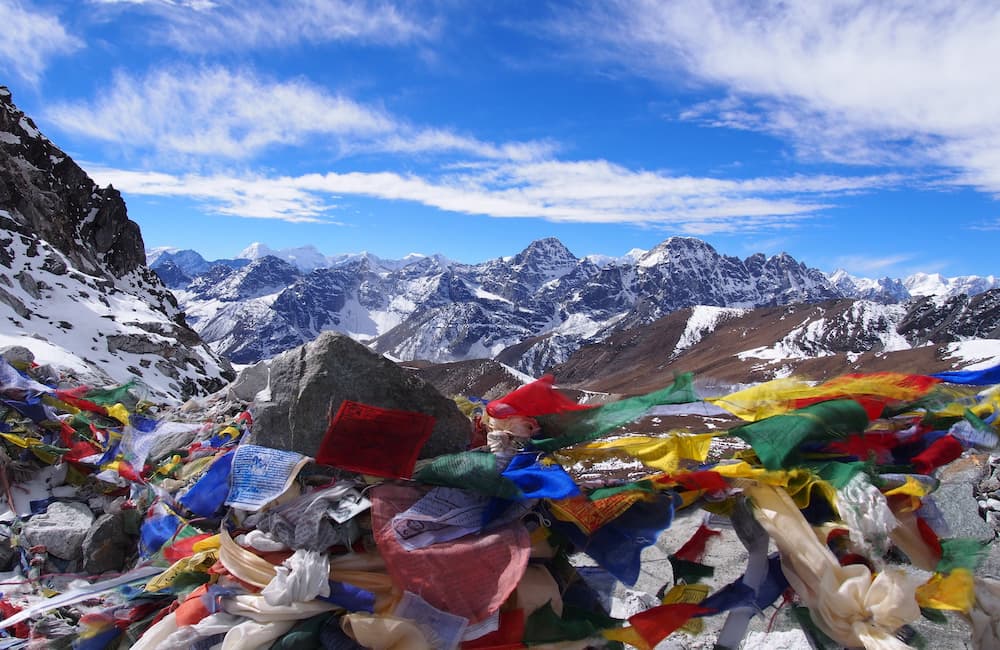
Related Trekking Packages(s)
Everest Base Camp Trek - 14 Days
Everest Three Passes Trek
Everest Basecamp with Island Peak Trek
Everest Short Trek
Everest Panorama Trek
Everest Basecamp with Cho La Pass Trek
Gokyo and Renjo La Pass Trek
Everest Base Camp Luxury Lodge Trek
Jiri to Everest Base Camp Trek
Everest Basecamp fly back by Helicopter
Mountain Flight-Everest
Everest Heli Tours
Related Blogs (s)
Everest Base Camp Trek Distance
Everest Base Camp Trek Difficulty A Comprehensive Guide
7 Best Everest Base Camp Trekking Packages in Nepal
Experience a Short Trek in the Everest Region
Foods and Accommodations during EBC Trek
Everest Base Camp Altitude Sickness
Everest Base Camp Trek in December
Everest Base Camp Helicopter Tour
Everest Base Camp Trek Fitness Requirements
Experience the Everest Luxury Lodge Trek
Gokyo Chola Pass with EBC trek
Everest Base Camp Trek Difficulties
The highest mountains in the world
Peak | Height above MSL |
Mount Everest | 8,848 m |
Godwin Austen (K2) | 8,611 m |
Kangchenjunga | 8,586 m |
Lhotse | 8,516 m |
Makalu | 8,485 m |
Cho Oyu | 8,188 m |
Dhaulagiri I | 8,167 m |
Manaslu | 8,163 m |
Nanga Parbat | 8,126 m |
Annapurna I | 8,091 m |
Gasherbrum I (K5) | 8,080 m |
Broad Peak (K3) | 8,051 m |
Gasherbrum II (K4) | 8,035 m |
Shishapangma / Gosainthan | 8,027 m |
Cultural Highlights: Festivals and Local Events Along the Route
Everest Base Camp Trek is not only about an adventurous journey, stunning Himalayas and delightful landscapes but also about the enriched cultures, traditions and lifestyles of the Sherpa People. Immerse yourself into the rich tapestry of cultures and experience unique aspects of different localities.
Everest region is home to the Sherpa people - renowned for its exceptional mountain climbing record and the struggle to reside at high altitudes and extreme temperatures. Experience their warm hospitality, authentic cultures, traditions and customs. Get a chance to delve deeper into their lifestyle in rugged and remote terrain. Overall, the Everest Trek allows visitors to have an exceptional experience enjoying one of the prominent ethnic groups of Nepal.
Spring season is the time for some festivals like Buddha Jayanti – the birth anniversary of Lord Gautam Buddha. Witness how the festival is celebrated in some Buddhist monasteries and add an amazing experience to the trekking journey. With a great view adding a unique experience makes this trek even better and worthwhile.
Autumn Season is an ideal time to do Everest Base Camp Trek, whether it is one of the most celebrated seasons in Nepal. During this season, Dashain and Tihar stand out as the foremost Nepalese festivals, serving as windows into the rich tapestry of local culture, cherished traditions, and the importance of family bonds. Celebrating this festival with sherpa people in the Everest region will be a unique and amazing experience for sure. Witness the region decorated with colorful lights taste a delicate meal and get a chance to participate in traditional rituals. Also, one of the most important festivals for the Sherpa people is Mani Rimdu, which falls in either October or November. If you are in Tengboche at the festive time, it's worth watching and enjoying monks dressed in colourful and intricate costumes to perform ritual dances.
Summer Season is the off-season for the Everest Trek wherever, where trekkers get to experience the serene beauty of the region, and farmlands and get a proper chance to learn about their typical cultures and traditions preserved from ancient times. Likewise, experience farming with the locals.
Winter Season offers a quieter insight into the Everest Region. During this time locals are less engaged with tourism and more engaged in their daily lives. Learn how they live their life in such a remote zone without getting proper facilities. It offers you a meaningful journey. However, in the winter season, Losar (Tibetan Festival) take place which offers a great opportunity to witness local traditions and cultural celebrations.
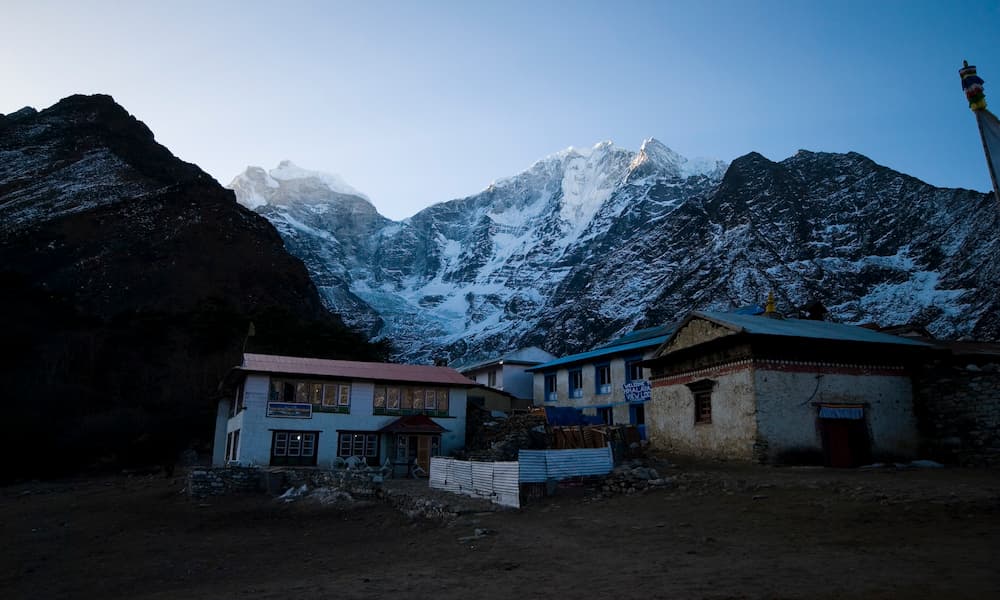
Peak Season for Everest Base Camp Expeditions
Mount Everest Base Camp is one of the worldwide renowned destinations for trekking where many trekkers visit for thrilling adventure and to admire stunning Himalayan peaks closely. One of the treks that assuredly provide an exceptional experience for a lifetime. However, visitors are searching for the best time to visit Everest Base Camp Trek and peak seasons for the journey.
The best time to go to Everest Base Camp is during Spring the months of March to May and Autumn the months of September to November. The trail takes you through mesmerizing forests with the sound of birds chirping. And the views are just awesome during the time. Likewise, Spring and Autumn are the peak seasons in Nepal to embark on any trek such as Everest Base Camp Trek, Annapurna Base Camp Trek, Mardi Himal Trek,Manaslu Circuit Trek and many more. The trekking trail will be crowded and enjoyable at the time. Interacting with other groups and sharing each other stories, the journey itself will be wonderful. It's highly improbable that you'll have the main trails all to yourself, and securing your top choice of accommodation might be challenging as well. Book in advance before a month to relish on desired accommodation.
Travelling with a guide is a better choice for Everest Trekking to reduce any difficulties that occur in the meantime. Due to hustling and bustling in the region for the Everest expedition, Lukla flights (the world's top ten dangerous Lukla Airport) tend to sell out well in advance, so it's preferable to book them as early as you can. Being the most popular trekking trail in Nepal, the EBC trail is filled with a high volume of visitors in peak season, but other many treks in Nepal seem less volume of visitors. During and Winter and Monsoon season, as it is the off-season for trekking which challenges with every Hillary step but the views and landscapes are awesome covered with snow and high chances of getting luxury teahouses along the trail.
If you looking for a serene experience while trekking to EBC in peak seasons, opt for an alternative route to Everest Trekking offers breathtaking landscapes, surreal Himalayan sights, and natural and cultural wonders.
Alternative Routes to Everest Base Camp Trekking
Escaping from hustle and bustle and making your way to Everest Base camp via different routes is one of the great choices to feel a serene ambience and enjoy the breathtaking natural and cultural wonders all the way. If you seeking adventure with peaceful surroundings then, the experience would be great for a lifetime. Here are some alternative routes to set foot on the most popular destinations Mount Everest (8848m) base camp.
Jiri to Everest Base Camp
Jiri to Everest Base Camp Trek is one of the most popular alternative routes that takes trekkers walking in the footsteps of legendary mountaineers Hillary and Tenjing. The Everest journey commences from a scenic and adventurous drive from Kathmandu to Jiri from where the trek takes place. Add at least a week to your total trekking days and enjoy a trekking trail from Jiri exploring two unique sides of Nepal.
Along the trekking trail, walking in a serene ambience, revel in the views of snow-capped Himalayan peaks, Mount Everest, Khumbu glacier, Everest base camp and Kalapatthar. The Jiri to Everest Base Camp Trek is a once-in-a-lifetime opportunity that allows plenty of time to acclimatize and explore Sherpa culture. The Jiri to Everest base camp trek is always the most talked about because what it offers lasts a lifetime.
Gokyo Lake Trek
Gokyo Lake Trek is one of the famous trekking routes in Nepal which immerses you in the breathtaking serene lake and stunning Himalayan Mt. Everest itself and many others. The trek commences from Lukla, the starting point of Everest Trek following the trail along the Dudh Koshi River that passes through small Sherpa settlements situated few and far between.
Experiencing the warm hospitality and a glimpse of the high Himalayas, the journey stops you at a noteworthy destination, Gokyo Lake – the fifth-highest lake in the world. Feel the serenity surrounding Gokyo lakes and get a chance to climb Gokyo Ri as well where you’ll be witnessing the magnificent views of Everest Himalayas such as Mt. Everest, Mt. Amadablam, Mt. Lhotse, Mt. Cho oyu and many more. Embarking on the journey to Gokyo Lake offers a comprehensive experience that encompasses much of what the Everest base camp has to offer. However, it grants the opportunity to behold stunning lakes and traverse breathtaking passes along the way. Lastly, you can combine the Gokyo Lake with the Everest Base Camp Trek.
Three Passes Trek
Three Passes Trek is one of the thrilling adventurous treks in Nepal that passes through the challenging Kongma La Pass (5540m), Cho La Pass (5420m), and Renjo La Pass(5360m). A great option to avoid EBC crowds and enjoy the serene landscapes, Himalayan vistas and charming settlements.
The journey starts from Lukla and takes you to Dingboche, from there head to Chukhung village and ascend Chukhung Ri. From here, the route goes to the Kongma La Pass, Cho La Pass and Renjo La Pass. Trekkers may enjoy views of the Khumbu region's majestic peaks, including Mt. Everest, Lhotse, and Makalu. Later after crossing high passes, sleeping at high elevations, and traveling through isolated and difficult terrain, the journey concludes at Lukla. The greatest way to experience Mount Everest closely and challenge yourself at every point will be the journey of a lifetime.
Arun Valley and Everest Base Camp Trek
Arun Valley and Everest Base Camp Trek is one of the exciting treks in the wilderness Himalayan region passes through many sherpa villages including various ethnic groups of Rai, Lumbu, Gurung, Tamang, Newar, Chhetri and Brahmin. Get acquainted with them and enhance your experience with their unique cultures, traditions and way of living.
It winds through the Arun Valley, nestled between the Sagarmatha and Makalu-Barun National Parks. While it shares parts of the traditional EBC route, it sheers off sufficiently to add a dash of novelty. Even during peak seasons, this path remains blissfully serene until you merge with the bustling EBC trail.
Island Peak summit
For seasoned mountaineers seeking a new challenge without the daunting heights and risks of Everest, Island Peak climbing and Mera Peak climbing presents an alluring option. Referred to as a 'trekking peak,' it offers a doable ascent with adequate climbing opportunities. The optimal times to undertake this adventure are during the peak trekking seasons of spring and autumn.
Island Peak's lower elevation compared to Everest grants a broader climbing window, ensuring safer and more enjoyable conditions. Following a route that mirrors much of the classic Everest Base Camp trek, the journey to Island Peak includes stunning vistas and ends at Kala Patthar, offering breathtaking views of the Everest Base Camp.
Mera Peak Summit
Mera Peak is the ultimate Himalayan adventure that takes you close to Mt. Everest and soars above 6476 meters above sea level. Requiring some technical Mountaineering skill, the Mera Peak is quite a difficult summit but after revelling in the magnificent views of five of the world’s highest Mountains; Kanchenjunga, Lhotse,Cho Oyo, Makalu and of course, Everest will relieve all your pain and difficulties.
The journey starts right after crossing Mingbo La Pass and enters the Khumbu Valley following the traditional EBC route. Later, experiencing the great Everest region with the majestic sights of the Himalayas and Khumbu icefall, embark on a thrilling helicopter journey to Mera Peak and conquer one of the majestic Himalayan summits. This adventure flawlessly blends the finest of trekking and mountaineering experiences into one exceptional trip. Renowned as one of the premier treks globally, ascending Mera Peak fulfils the dreams of many, being the highest trekking peak in Nepal.
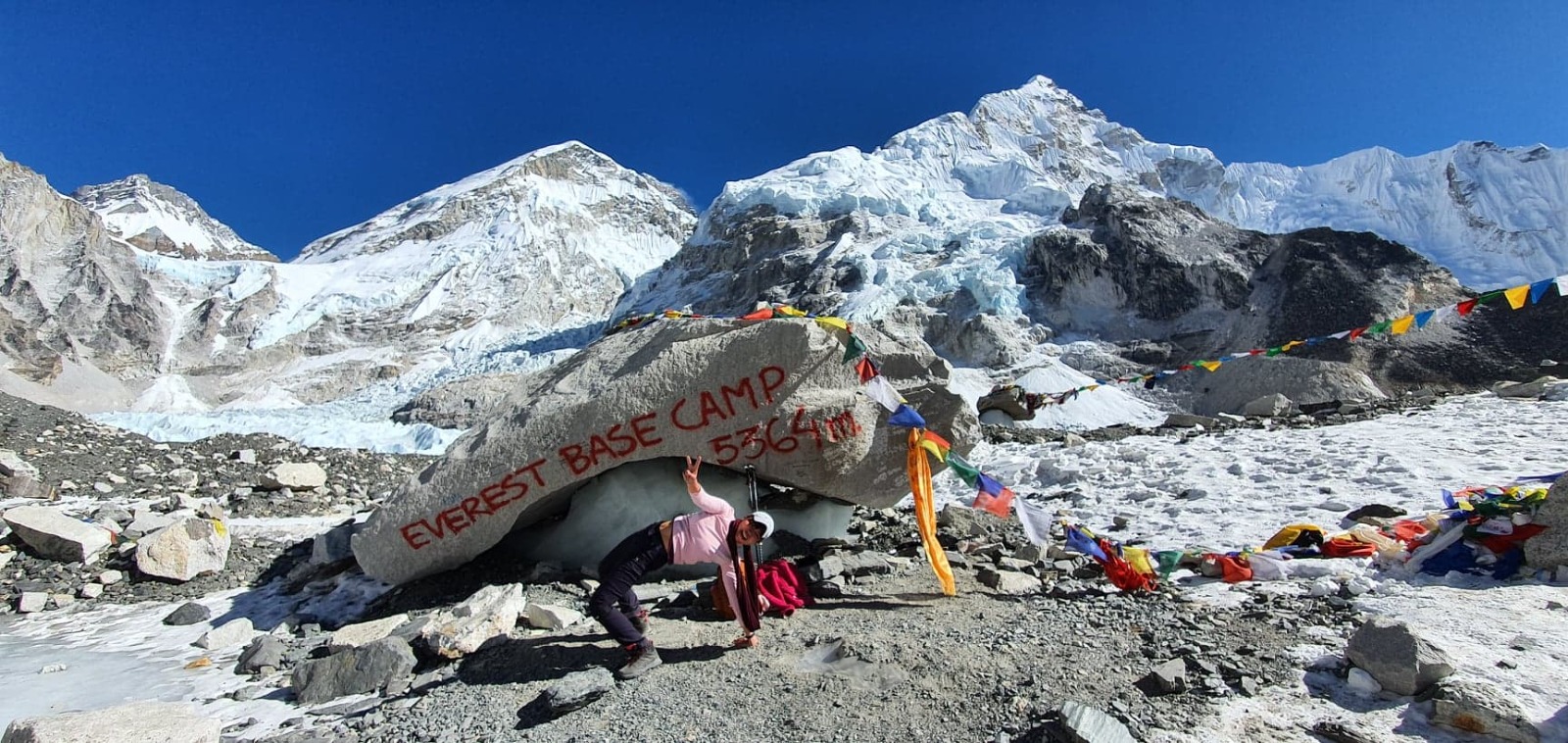
Fitness Requirements for Everest Base Camp Trek
Everest Base Camp Trek is a complete package of challenges, adventure and thrill which requires a significant amount of physical and mental preparation. Everest Base Camp Trek is absolutely a difficult one but not an impossible one. Anyone can complete this trek if the individuals focus on concrete EBC fitness requirements. Planning and Preparation is the measure key to conquering the Everest Base Camp with lots of excitement.
Adequate preparation such as cardiovascular exercises, leg strengthening, jogging, hiking, swimming and such like others will help to achieve the dreamy destination. Focus at least 30 minutes every day a month before you embark on an Everest trek.
Before commencing the journey ensure your health conditions with your doctor whether it is fine to trek in high altitude or not. Because measure conditions like heart problems and kidney problems can’t make their trek to higher altitudes.
The trek involves usually 6-7 hours of walking. Normally before 3 months start your training and prepare your body to tackle any difficulties that occur during the trial. Here are some tips that will help to boost your stamina and power to conquer the trek easily:
- Focus on cardiovascular exercises, leg strengthening, hiking long hours, jogging, swimming and extracurricular activities.
- Do yoga and meditation to improve your flexibility, balance, and mental focus.
- Carry a heavy backpack and hike for some hours nearest your area.
- Engage in some activities like; running, cycling and swimming.
Altitude-related problems on Everest Base Camp Trek
Every year thousands of people undertake the voyage of Everest Base Camp Trek. The trekkers have to experience cold weather and high-altitude difficulties there are numerous hurdles encountered throughout the journey. Everest Base Camp Trek is one of the high-altitude treks which may be difficult to adjust in the highly elevated terrain so, be cautious about altitude sickness. Altitude sickness is a common risk as you are already in a high region where the air is thin and no vegetation.
Know about the symptoms of altitude sickness such as headache, loss of appetite, shortness of breath, fatigue, difficulty sleeping, nausea, rapid pulse and extreme dehydration. If you feel any of these symptoms on your body, make sure to inform our experienced guide immediately and they will help you with the medical help or descend back to lower altitude.
Look out for the tips that will help to avoid altitude sickness in Everest Base Camp Trek:
- Ascend Slowly
- Proper Acclimatization Rest
- Avoid Alcohol, Cigarettes & Tobacco
- Drink plenty of warm water
- Eat Well and Plenty
- Be Mentally Prepared
Note: Follow the mentioned tips and make your trip easy and stunning.
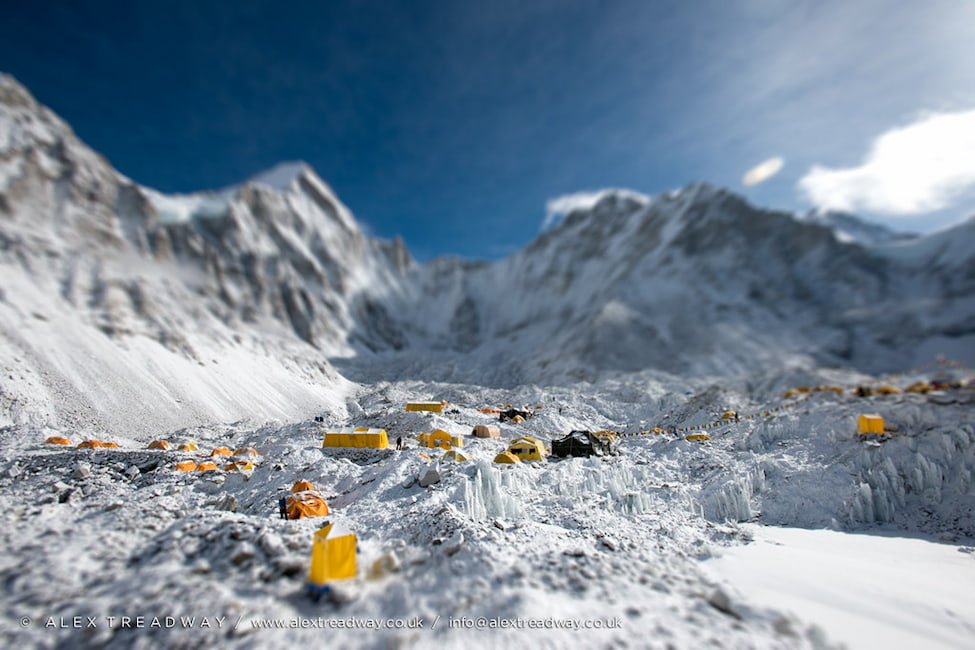
Packing list for Everest Base Camp trek
Everyone is questioning what to pack for the Everest Base Camp Trek. it depends laboriously upon the season or time you are embarking on. Make sure to bring the layers to be warm and comfortable throughout the EBC Trek. Due to unpredictable weather conditions, prepare yourself with warm clothing and limited gear, making the trek easy and enhancing the overall trekking experience. Here we provide a proper packing list while trekking to Everest Base Camp ensuring to have a safe and comfortable journey.
Clothing
Body Wear
- Moisture-wicking long-sleeve t-shirts (2)
- Moisture-wicking short-sleeve t-shirt (1)
- Heavy fleece or down jacket
- Waterproof jacket with hood
- Windbreaker
- Raincoat
- Fleece pants
- Trekking pants (2)
- Hiking shorts (1)
- Waterproof pants
- Hiking socks (10)
- Warm thermal socks (1)
- Long underwear (2)
- Underwear (10)
Footwear
- Hiking boots with ankle support
- Camp shoes or tennis shoes
Hand Wear
- Light inner gloves/glove liners
- Insulated wool or down mittens/gloves
Headwear
- Sunglasses
- Broad-brimmed hat
- Neck gaiter or bandana (for sun protection)
- Wool hat or balaclava
- Gaiters (required in Dec-Feb)
Trekking Gear
- Duffle bag for carrying gear via porters (provided by Eternal Himalaya if you join with us)
- 40L Daypack for carrying personal items
- Waterproof cover for daypack
- Snacks (combine protein & carbs for well-balanced energy)
- Thermos (for hot beverages)
- Sleeping bag rated to -18°C/ 0°F
- Trekking poles
- Headlamp with extra batteries
- Lightweight water filter or water purification tablets
- Drybags in several sizes
- Stuff sacks for dirty clothes/shoes
- Camera with extra batteries and memory cards
- Small lock(s) for duffle bag and daypack
- Diamox (for altitude sickness)
Toiletries
- Toilet Paper
- Personal prescriptions
- Soap
- Toothbrush/toothpaste
- Razor (as needed)
- Shampoo
- Feminine hygiene products (as needed)
Personal Care items
- Sunscreen
- Lip balm with sunscreen
- Deodorant
- Wet wipes
- Hand sanitiser
- Hairbrush
- Hair ties
- Face lotion
Extra Supplies
- Portable solar charger/power bank
- Book
- Journal/pen
- Playing cards
Travel Documents for Everest Base Camp Trek
The most important for Everest Base Camp Trek is travel documents. Requires for obtaining permits, acquiring a Nepal Visa and much further processing. Look out for the documents needed for Everest Base Camp Trek:
- Passport with a valid date of 6 months.
- Passport copies
- Nepal Visa (obtain Nepal visa—bring $30 (15 Days) or $50 (30 Days) for Visa Application
- Nepali Cash (preparing for some areas)
- 3-4 Passport-sized photos if needed for permits
- Travel Insurance
Tips for high-altitude Everest trekking
- Preparation is key to a successful trip.
- Focus on some physical fitness exercises and activities before a couple of months.
- Ensure your gear is in great condition for a safe and comfortable trek.
- Maintain hydration level by drinking plenty of water throughout the Everest Trek.
- Pack lightly with the required and limited clothing and gear.
- Ascend slowly to allow your body to adjust to the decreasing oxygen levels.
- Eat a well-balanced diet rich in carbohydrates, proteins, and healthy fats.
- Wear comfortable, moisture-wicking clothing that can be layered for warmth.
- Apply high SPF sunscreen, wear sunglasses and a brimmed hat.
- Listen to your body and pay attention to the altitude sickness symptoms.
- Respect Local customs and cultures.
- Familiarize yourself with the emergency evacuation procedures in the region in case medical assistance is needed urgently.
People also asked:
How long is the trek to Everest Base Camp?
Everest Base Camp Trek is about 14 days according to our itinerary. It may vary depending on individual interests and preferences. The distance covered approximately 130km from Kathmandu.
How many miles is the Everest Base Camp Trek?
Mt. Everest Base Camp typically 12-14 days of trekking. The round trip to EBC covers a distance of 130km/80 miles.
When to trek Everest Base Camp?
Spring and Autumn seasons are the ideal seasons to trek to Everest Base camp. During this time, you’ll be rewarded with clear Himalayan sights, a rhododendron-embellished trail and sunny days present an enjoyable journey.
Is it safe to trek to Everest Base Camp?
The Everest Base Camp Trek route is well-trodden and extremely safe in Nepal. In comparison to summitting Everest, the trek to Everest Base Camp is far from dangerous.
Is the Everest base camp trek worth it?
Of course, Everest Trek is a once–in–a–lifetime journey in the wilderness Himalayan Everest Region which sets you in the awe-inspiring top worldwide destination at the lap of Mount Everest (8848m). The trek to EBC will amaze you with stunning natural and admiring cultural wonders along the route. Also surround yourself with majestic peaks such as: Mt. Amadablam, Mt. Cho oyu, Mt. Lhotse, Mt. Makalu and Mt. Lobuche. In addition, takes you to some of the most rural and ancient monasteries. Aside from the renowned K2 Mountain and Mt. Kilimanjaro, Mount Everest stands out as one of the most frequented destinations worldwide, and its allure is truly worthwhile. The trek to Everest Base Camp promises an indelible experience, unparalleled in its natural magnificence.
Can a beginner do an Everest base camp trek?
Yes, for a novice trekker, Everest Base Camp is the perfect trek to taste adventure and surreal natural beauty. But only possible with adequate preparation for physical and mental fitness.
How much does it cost to trek Everest Base Camp?
The 14-day Everest Base Camp Trek costs range from $1000 to $3500 depending upon the routes, services and duration. If you opt. for Everest Luxury Lodge Trek, the cost may range from $2400 to $3000. And if you opt. for Everest Helicopter Tour, the cost may range from $3000 to $4000. However, it may fluctuate depending on seasons and the passing year.
How high is Everest Base Camp?
Everest Base Camp Trek is situated at an elevation of 5364m/17,598ft above sea level. The base camp of the world’s highest Mountain- Everest (8848m). Possible to reach at base camp by trekking and helicopter rides.
Conclusions
The best time to trek to Everest Base Camp is intuitive and depends on your preferences and interests. Both spring and autumn offer marvellous trekking experiences, each with its distinctive advantages. Eventually, selecting the right time involves reimbursing factors like weather, crowd levels, and personal preparedness for the journey. The stunning landscapes, colourful local festivals, blooming red rhododendrons, and refreshing cool gusts make this trek even more noteworthy during the ideal time: Spring and Autumn.
If you’re planning to trek to Everest Base Camp, make sure to choose the right stunning experience that can be cherished for a lifetime. Join the Eternal Himalaya Team to make your Everest Base Camp journey hassle-free!









